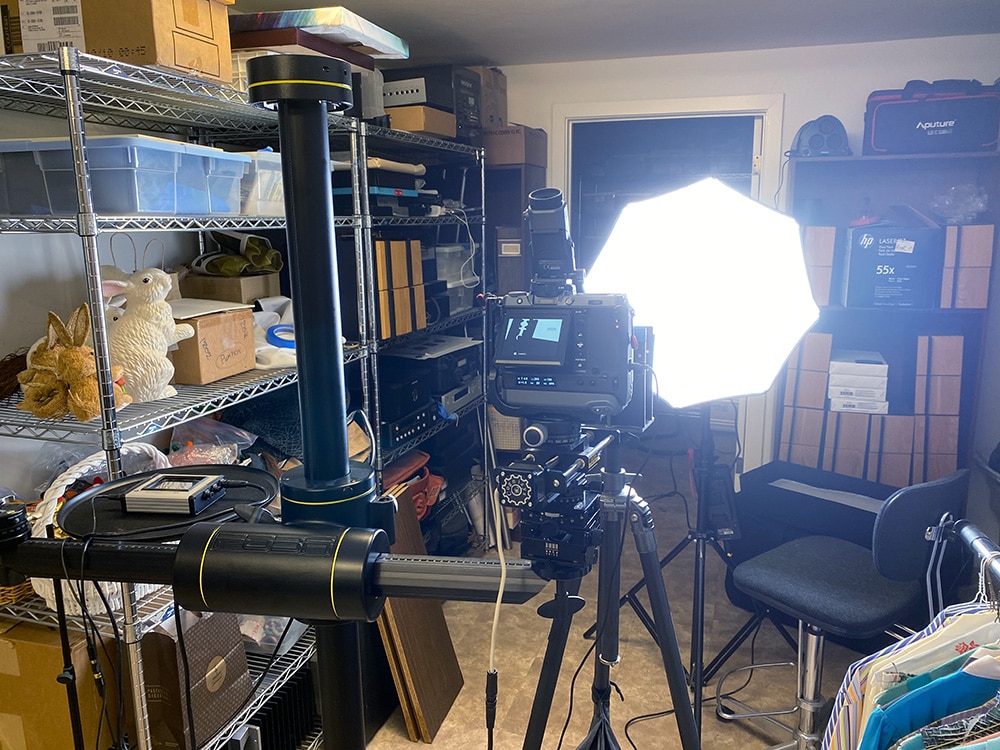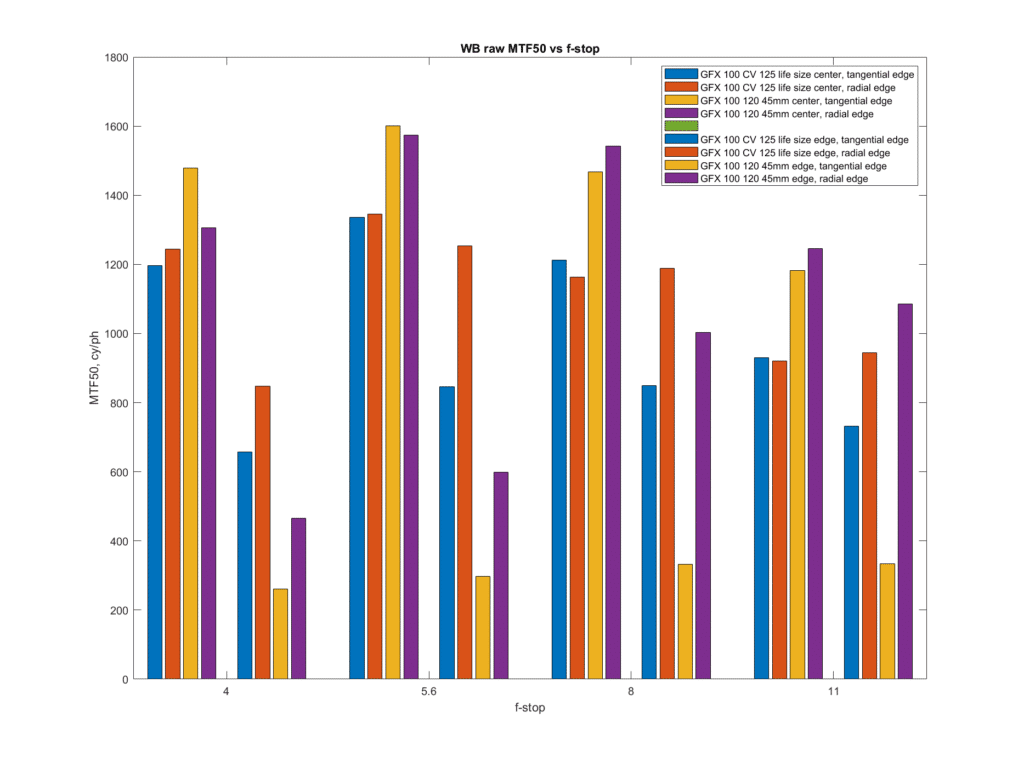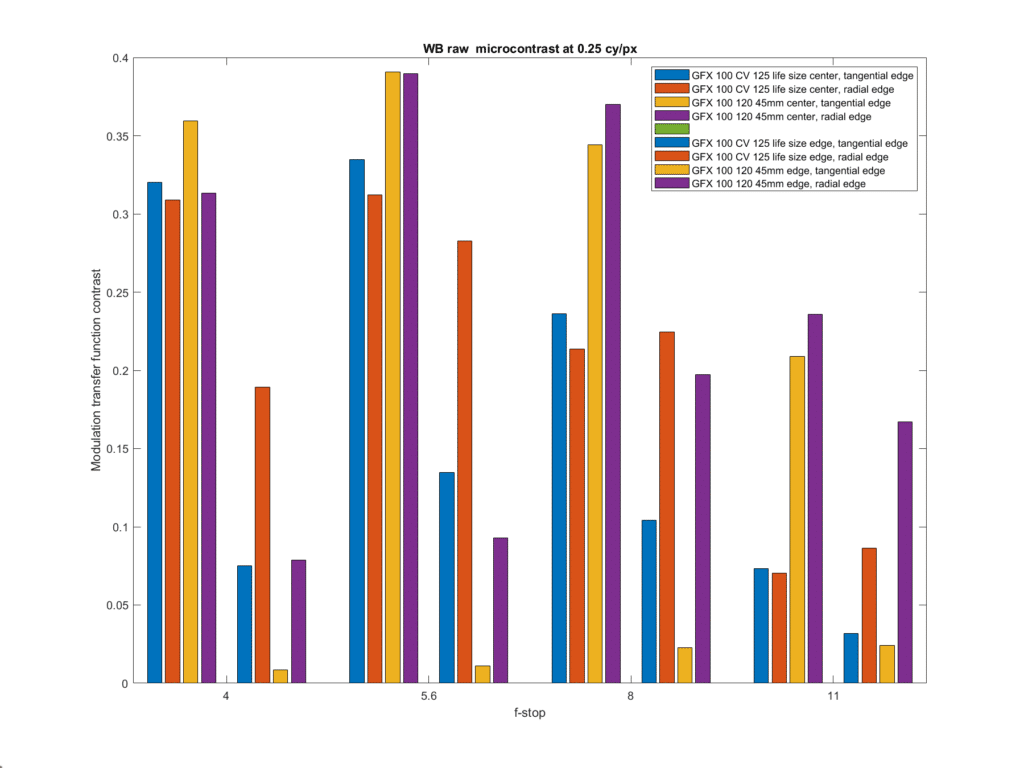This is one in a series of posts on the Fujifilm GFX 100. You should be able to find all the posts about that camera in the Category List on the right sidebar, below the Articles widget. There’s a drop-down menu there that you can use to get to all the posts in this series; just look for “GFX 100”. Since it’s more about the lenses than the camera, I’m also tagging it with the other Fuji GFX tags.
I’ve been posting a lot recently about the 120 mm f/4 GF macro lens for the GFX. I found it a good performer at 1:2, at minimum focusing distance (MFD) with no extension tubes, but that it had really soft edges and a lot of focus curvature at MFD with 36 mm of tubes. In this post, I tested it at 1:1 with a 45 mm tube,a and found it credible on-axis but soft on the right edge of the frame. I reported those results numerically and visually, using the time honored sharpness target of a banknote. The 120/4 GF was soft in the corners and edges at MFD with 18mm, 36mm, and 45mm of extension by tubes.
For copy applications, and for some 3D subjects that require extension tubes, the 120/4 GF just isn’t cutting it.
So I decided to look for an alternative. The first lens I tried works much better than the 120/4 GF for close focusing, as you’ll see if you read on. My first candidate was the Cosina-Voigtlander (CV) 125 mm f/2.5 Apo-Lanthar. My copy is in a Nikon F mount. I put a FotoDiox F-to-G converter on the back of the lens, a Fuji 45 mm extension tube behind that, and mounted the stack to a GFX 100. I set the lens to indicated f/5.6. Using a Cognisys rail, I made a series of 150 exposures with an 20 micrometer (um) shift between one.
Here’s the setup:
Here’s the test procedure:
- GFX 100
- Foba camera stand
- C1 head
- 1 45mm Fuji extension tube for 120/4 GF
- 1 18mm Fuji extension tube for CV 125/2.5
- Lens focused to close to as near as it would focus, for the 120/4
- Lens focused to get to 1:1 for the CV 125/2.5
- ISO 100
- Electronic shutter
- 10-second self timer
- Indicated f/4 through f/11 in whole-stop steps
- Exposure time adjusted in M mode
- Cognisys rail 150 exposures, 20 um step size
- Initial focus short of target
- Convert RAF to DNG using Adobe DNG Converter
- Extract raw mosaics with dcraw
- Extract slanted edge for each raw plane in a Matlab program the Jack Hogan originally wrote, and that I’ve been modifying for years.
- Analyze the slanted edges and produce MTF curves using MTF Mapper (great program; thanks, Frans)
- Fit curves to the MTF Mapper MTF50 values in Matlab
- Correct for systematic GFX focus bracketing inconsistencies
- Analyze and graph in Matlab
The results:
The vertical axis is MTF50 in cycles per picture height. Higher is sharper. The horizontal axis is f-stop.
- The leftmost blue columns in the first four-bar grouping are for the CV lens, in the center of the image, with a vertical edge.
- The leftmost blue columns in the second four-bar grouping are for the CV lens, at the center of the image, with a vertical edge.
- The red columns in the first four-bar grouping are for the CV lens, at the right edge of the image, with a horizontal edge.
- The red columns in the second four-bar grouping are for the CV lens, at the right edge of the image, with a horizontal edge.
- The yellow columns in the first four-bar grouping are for the GF lens, in the center of the image, with a vertical edge.
- The yellow columns in the second four-bar grouping are for the GF lens, in the center of the image, with a vertical edge.
- The purple in the first four-bar grouping are for the GF lens, at the right edge of the image, with a horizontal edge.
- The purple columns in the second four-bar grouping are for the GF lens, at the right edge of the image, with a horizontal edge.
My conclusions:
- In the center of the image, the GF lens is somewhat sharper.
- At the right edge of the image, the CV lens is dramatically sharper.
- The best f-stops for combined center and edge performance are f/5.6 and f/8 for both lenses. These are indicated f-stops. Effective f-stops will be narrower. Effective f-stop for th GF is between 1 third of a stop and two thirds of a stop wider at 1:1 than the effective f-stop for the CV lens.
- This difference in effective f-stop is responsible for the degraded performance of the CV lens at f/11.
- Both lenses perform worse for tangential (vertical) edges near the right edge of the image. In the case of the GF lens, much worse.
Looking at microcontrast, which I’m defining for the purpose of this post as contrast at one quarter of a cycle per pixel:
If microcontrast is important, f/5.6 is the best stop for the CV lens. Depending on the weighting of center to edge performance, you could argue for either f/5.6 or f/8 for the GF lens. At 1:1, you don’t have a lot of flexibility in aperture with either lens.



Leave a Reply